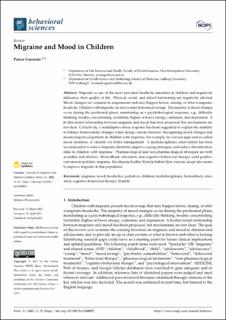Migraine and Mood in Children
| dc.contributor.author | Gazerani, Parisa | |
| dc.date.accessioned | 2021-06-25T14:00:51Z | |
| dc.date.available | 2021-06-25T14:00:51Z | |
| dc.date.created | 2021-05-25T10:24:38Z | |
| dc.date.issued | 2021-04-14 | |
| dc.identifier.citation | Behavioral Sciences. 2021, 11 (4), 1-15). | en_US |
| dc.identifier.issn | 2076-328X | |
| dc.identifier.uri | https://hdl.handle.net/11250/2761405 | |
| dc.description.abstract | Migraine is one of the most prevalent headache disorders in children and negatively influences their quality of life. Physical, social, and school functioning are negatively affected. Mood changes are common in migraineurs and may happen before, during, or after a migraine headache. Children with migraine are not exempt from mood swings. The majority of mood changes occur during the prodromal phase, manifesting as a psychobiological response, e.g., difficulty thinking, trouble concentrating, irritability, higher or lower energy, confusion, and depression. A bi-directional relationship between migraine and mood has been proposed, but mechanisms are not clear. Collectively, a maladaptive stress response has been suggested to explain the inability to balance homoeostatic changes when facing various stressors. Recognizing mood changes and monitoring mood patterns in children with migraine, for example, by various apps and so-called mood monitors, is valuable for better management. A multidisciplinary intervention has been recommended to reduce migraine disability, improve coping strategies, and reduce chronification risks in children with migraine. Pharmacological and non-pharmacological strategies are both available and effective. Biofeedback, relaxation, and cognitive-behavioral therapy yield positive outcomes in pediatric migraine. Developing healthy lifestyle habits (diet, exercise, sleep) also seems to improve migraine in this population. | en_US |
| dc.language.iso | eng | en_US |
| dc.publisher | MDPI | en_US |
| dc.relation.ispartofseries | Behavioral Sciences;volume 11, issue 4 | |
| dc.rights | Navngivelse 4.0 Internasjonal | * |
| dc.rights.uri | http://creativecommons.org/licenses/by/4.0/deed.no | * |
| dc.subject | Migraine | en_US |
| dc.subject | Mood | en_US |
| dc.subject | Headaches | en_US |
| dc.subject | Pediatrics | en_US |
| dc.subject | Children | en_US |
| dc.subject | Multidisciplinary | en_US |
| dc.subject | Biofeedback | en_US |
| dc.title | Migraine and Mood in Children | en_US |
| dc.type | Peer reviewed | en_US |
| dc.type | Journal article | en_US |
| dc.description.version | publishedVersion | en_US |
| dc.rights.holder | © 2021 by the author. | en_US |
| dc.source.articlenumber | 52 | en_US |
| cristin.ispublished | true | |
| cristin.fulltext | original | |
| cristin.qualitycode | 1 | |
| dc.identifier.doi | https://doi.org/10.3390/bs11040052 | |
| dc.identifier.cristin | 1911611 | |
| dc.source.journal | Behavioral Sciences | en_US |
| dc.source.volume | 11 | en_US |
| dc.source.issue | 4 | en_US |
| dc.source.pagenumber | 1-15 | en_US |
Tilhørende fil(er)
Denne innførselen finnes i følgende samling(er)
-
HV - Institutt for naturvitenskapelige helsefag [395]
HV - Department of Life Sciences and Health -
Publikasjoner fra Cristin [3256]

